The simpler the equipment, the more reliable it is? Pros and cons of a floor-standing gas boiler
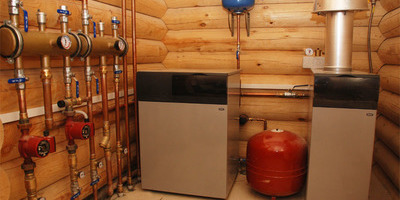
The gas boiler is capable convert the energy of the burned gas into heat.
This device is used to heat the coolant in the heating system, and Some models are capable of heating water., used for household and other needs.
Gas boiler device
Before describing the main elements of the boiler and the principle of its operation, we note that The "heart" of the device is the heat exchanger, are made from various materials.
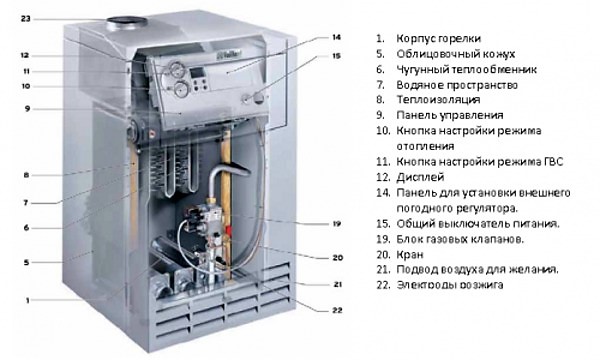
Photo 1. Diagram of the internal structure of a floor-standing gas boiler. The arrows indicate the main parts.
Cheap models are sold with steel filling. Stainless steel provides protection against water hammer, corrosion and thermal resistance, and low weight of the device.
Expensive models are equipped with cast ironThey are much heavier and cost one and a half to two times more expensive compared to their steel "brothers". However, cast iron offers increased thermal power and a many times longer service life.
Important! There are boilers with two types of combustion chambers. Open option takes the oxygen needed for combustion from the room. The requirements for the system's chimney in this case increase. Closed The option takes oxygen from the street, it is more practical, but it costs more.
Components and operating principle
Having learned that the main part of the boiler is made of various materials, let's move on to other elements of the device.
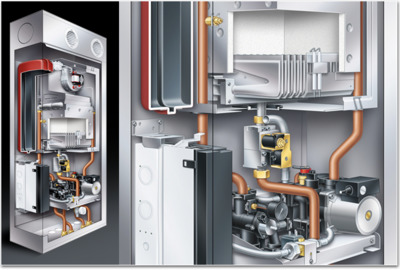
- Capacity for heating the coolant.
- Couplings, supplying and removing the coolant.
- Casing, for fastening the pipe that removes combustion products.
- Gas burner.
- Igniter.
- Automation, which tracks the work of the spirit of the previous elements.
- Thermocouple is responsible for the temperature of the coolant.
- Coil heats water for hot water supply (only in models with two contours).
At the bottom of the boiler body is a burner. Above it hangs a heat exchanger in the form of thin, flat containers filled with coolant. The carrier enters through the feed pipe, heats up and continues its way to the heating system. Combustion products are removed through the casing, due to natural draft.
Automatic control monitors the condition of the burner and igniter. If the pilot light goes out, the gas supply to the system is immediately stopped completely. The burner operation is periodically interrupted if the temperature of the carrier has reached the required value. The thermocouple is responsible for this, preventing the boiling of the coolant.
Double-circuit models are equipped with a coil for hot water supply. This part encircles the heat exchanger in a circle and is also heated by the burner. Through a separate branch Cold water enters the coil, and hot water enters the DHW system.
Reference. Old models of AGV have a different heat exchanger structure. They are characterized by reduced efficiency, equal 70%They are no longer in production, but may still be available for sale.
Floor VS Wall Mounted, What's the Difference
The main differences are - dimensions, weight and power. The floor version usually looks like a large box, 800x500x600 mm weight from 100 kg. The wall-mounted boiler is comparable to a kitchen drawer (700x400x300 mm) weight less than 50 kg.
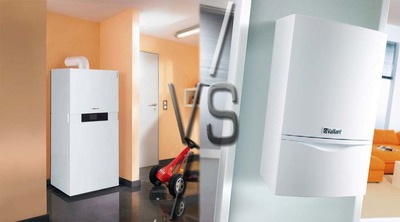
Wall-mounted boilers are used to heat small rooms. Their power rarely exceeds 30 kW. While their floor relatives have the characteristics 10-500 kW.
Structurally mounted devices more difficult floor-standing. For compactness and ease of installation, in addition to the standard ones, all kinds of pressure gauges, piping, pumps and other components are built into the device body. This leads to the fact that wall-mounted boilers require significant financial costs in the event of a breakdown.
Candidate's merits
Let's go further and give a little praise to the underfloor heating system.
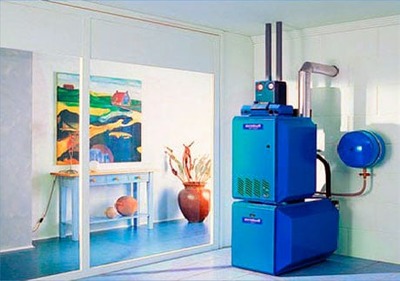
- The power of the weakest (cheapest) model of a floor-standing boiler will be enough for heating a room with an area of 500 sq. m. under ideal conditions: minimum heat loss, ceiling height no higher than 3 meters.
- The design of modern floor-standing units is such that the temperature of the combustion products at the outlet less than 70 °C. The boilers are highly efficient and are capable of providing a comfortable indoor environment with low gas consumption.
- The last plus is that chimney, left over from a solid fuel stove or boiler, can be improved for the new model.
Important! The boiler's thermal power can be accurately calculated only specialist, because the formula includes: room size, number of openings, wall thickness, quality of thermal insulation.
Flaws
In this section only two points, but they can become a headache for any homeowner.
Firstly, permission to install boiler. To obtain it, we write an application to the organization that supplies gas. A problem may arise here, such organizations may well refuse.
Secondly, to place a floor-standing boiler it is necessary separate room, which meets certain requirements.
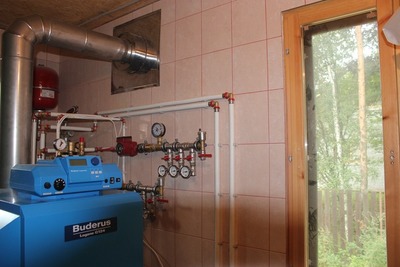
- Room, uninhabited with a ceiling height of more than 2.2 m.
- Area of the premises minimum 4 sq. m. for one device.
- The walls are "bare" without finishing with flammable materials.
- The floor is level concrete.
- Width door opening more than 0.8 m.
- Window street, area 0.3 sq. m.
The price of the issue
Cost of a floor standing boiler depends on its characteristics. For example, single-circuit model, with a stainless steel heat exchanger and an open combustion chamber will do in 20-30 thousand rubles. Powerful "monsters" are going on sale 500 kW and priced at 400 thousand rubles.
If we talk about private matters house with an area of 100-200 sq. m., then for good dual-circuit the boiler will have to be given away about 60 thousand rubles
Useful video
The video discusses the advantages and disadvantages of a floor-standing gas boiler in comparison with a wall-mounted one.
To sum it up
Installing your own heating system is a tempting idea. A properly selected floor-standing gas boiler will give you thermal independence, and its installation will pay for itself in just two years.
Main, choose the right room for the boiler room. It is advisable to assign her a place in basement or ground floor. It has to do with the level. noise, which produces the device. At night 40-60 dB will prevent you from sleeping if the bedroom is nearby.






Comments